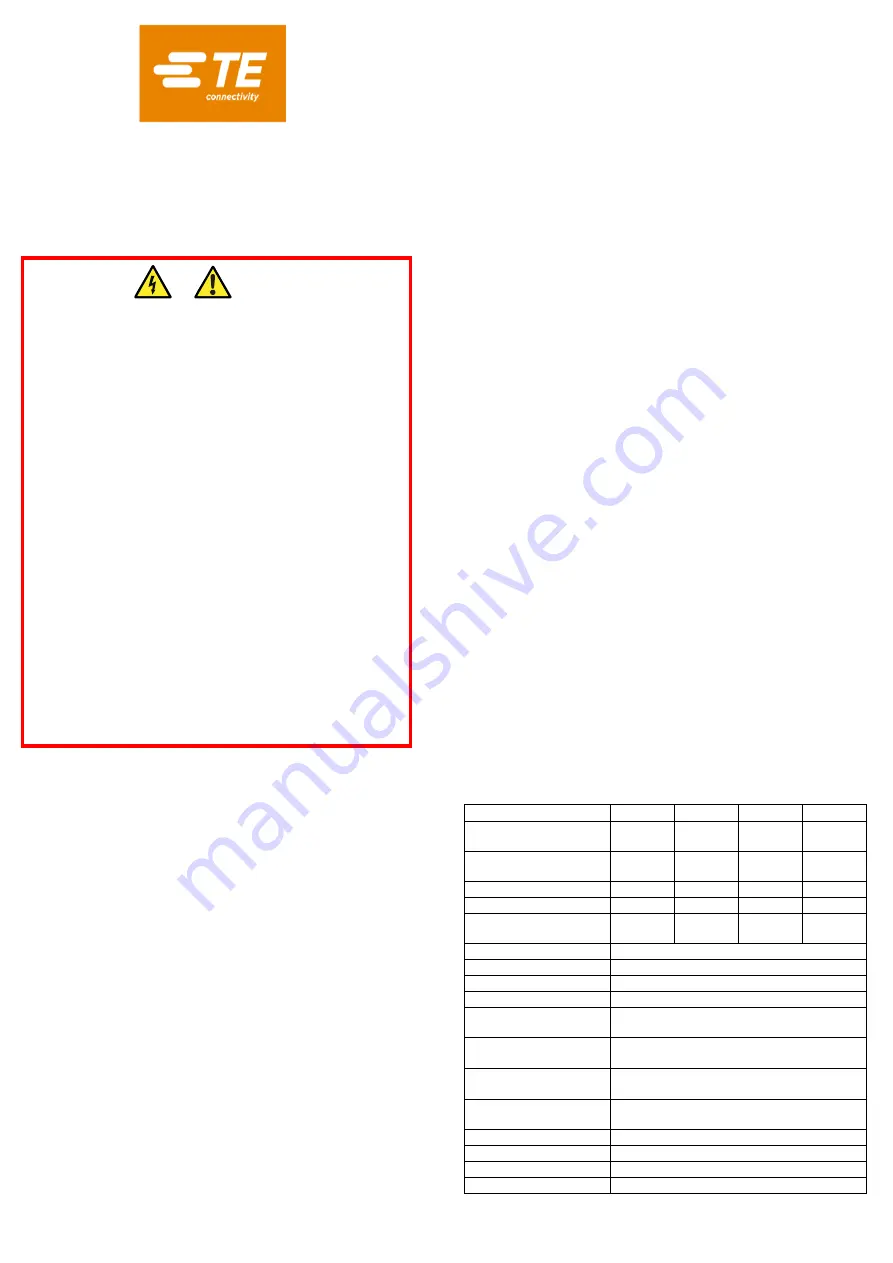
Installation and
Operating Instructions
Synchro-check Monitor PLL/D-100/120-UL,
PLL/D-173/240-UL, PLL/D-380/480-UL,
PLL/D-277/500-UL DIN-rail mounted
Safety
The unit was designed in accordance with BS EN 600255-6 and -27 –
Permanently connected use, Normal condition. Insulation category III,
pollution degree 2, basic insulation for rated voltage. Measurement
Category III.
EMC Installation Requirements
This unit has been designed to provide protection against EM (electro-
magnetic) interference in line, in accordance with BS EN 61000-6-2 and -
6-4. Precautions necessary to provide proper operation of this and
adjacent equipment will be installation dependent and so the following
can only be general guidance:
Avoid routing wiring to this unit alongside cables and products
that are, or could be, a source of interference.
To protect the product against incorrect operation or permanent
damage, surge transients must be controlled. It is good EMC
practice to suppress differential surges to 2kV or less at the
source. The unit has been designed to automatically recover
from typical transients, however in extreme circumstances it
may be necessary to temporarily disconnect the auxiliary
supply for a period of greater than 5 seconds to restore correct
operation.
Screened communication leads are recommended and may be
required. These and other connecting leads may require the
fitting of RF suppression components, such as ferrite
absorbers, line filters etc., if RF fields cause problems.
It is good practice to install sensitive electronic instruments that
are performing critical functions in EMC enclosures that protect
against electrical interference causing a disturbance in
function.
Wiring
All connections are made to screw clamp terminals. Terminals will accept
0.05 - 2.5mm2 (30 - 12 AWG) stranded or solid core cables. Terminal
screws should be tightened to 0.5 Nm (4.5 lb.in) Choice of cable should
meet local regulations.
For UL approved installation
, use National Electrical Code (NEC) Class 1
wiring. Use copper conductors only, rated 600V / 75°C minimum.
Fusing
A suitable switch or circuit breaker conforming to the relevant parts of IEC
60947-1 and IEC 60947-3 should be included in the building installation.
It should be positioned so as to be easy to operate, in close proximity to
the equipment, and clearly identified as the disconnecting device.
This unit must be provided with an external fuse in voltage supply lines.
Lines must be fused with a quick blow fuse 1A maximum. Choose fuse of
a type and with a breaking capacity appropriate to the supply and in
accordance with local regulations.
For UL approved installations:
UL listed branch circuit fuses, suitable for the installation voltage, shall be
provided and installed in accordance with national installation code – 1A
fast acting AC rated at the input.
Maintenance
In normal use, little or no maintenance is needed. Where used, ensure
any CT secondary circuits are short circuited prior to carrying out
installation or maintenance of the unit. As appropriate for service
conditions, isolate electrical power, inspect the unit and remove any dust
or other foreign material present. Periodically check all connections for
freedom from corrosion and screw tightness, particularly if vibration is
present.
Introduction
This unit compares the voltage, frequency and phase angle of two
supplies and operates a relay according to the synchronicity of the
supplies. If the two supplies cease to match, the relay operates to
provide a control output. The relay output can be used for alarm or
control purposes.
The unit also provides a dead bus function. If the bus supply fails, the
relay operates and the output can be used to switch in an emergency
generator. LEDs indicate power on, relay and dead bus status.
Controls on the front panel set the trip points at which the relays and
LEDs operate:
Degree of synchronicity Ux (%Volts)
Nominal voltage (Un)
Dead bus function on/off
The unit is powered from the generator supply.
These instructions contain important safety information. Please read
them thoroughly before commissioning, operating or maintenance of the
unit.
Specification
Parameter
PLL/PLD
100/120
173/240
380/480
277/500
Rated Vg range Un
57-69V
100-
139V
220-
277V
277-
500V
Overload capacity
- continuous
87V
174V
346V
600V
- 10s max.
104V
209V
416V
700V
Minimum supply Vg Uon
35V
60V
132V
166V
Burden on supply (Max)
2 VA /
1.6W
2.7 VA /
1.7W
4 VA /
2.2W
5 VA /
2.8W
Frequency range
45-65 Hz
Deadbus on Udbon
25% Uon
Deadbus off Udboff
50% Uon
Sync Tolerance
10-30% Volts
Relay contacts:
for
general switching
2 x changeover, volt-free
Load capacity - a.c.
250V @ 10A, B300
General purpose 70°C
Load capacity - d.c.
(Not UL rated)
30V 8A
Insulation
3 kV/min between adjacent relays
4KV/min to measuring inputs
Mech. endurance
30x10
6
operations
Other Data:
Dimensions
90 x 105 x 64 mm
Weight
(100/208/380/277)
291 / 335 / 332 / 335 g
Warnings
During normal operation, voltages hazardous to life
may be present at some of the terminals of this unit.
Installation and servicing should be performed only
by qualified, properly trained personnel abiding by
local regulations.
Ensure all supplies are de-
energised before attempting connection or other
procedures.
It is recommended adjustments be made with the
supplies de-energised, but if this is not possible,
then extreme caution should be exercised.
Terminals should not be user accessible after
installation and external installation provisions must
be sufficient to prevent hazards under fault
conditions.
This unit is not intended to function as part of a
system providing the sole means of fault protection -
good engineering practice dictates that any critical
function be protected by at least two independent
and diverse means.
The unit does not have internal fuses therefore
external fuses must be used for protection and
safety under fault conditions.
If this equipment is used in a manner not specified
by the manufacturer, protection provided by the
equipment may be impaired.
Caution: Risk of
Electric Shock and
Danger






















